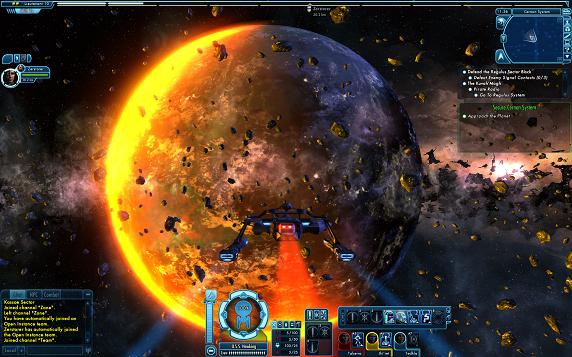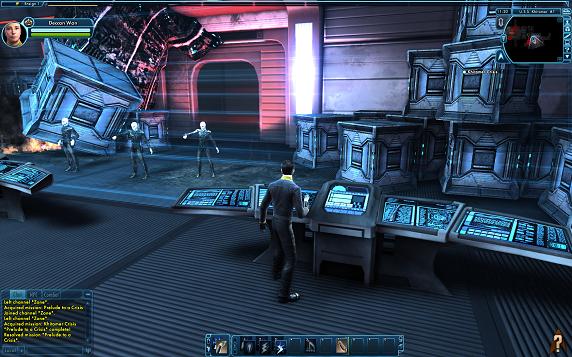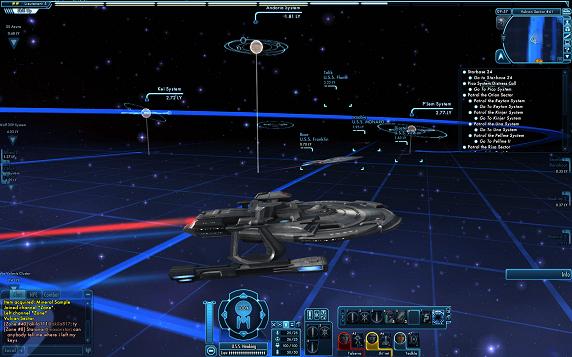
I feel guilty just for admitting that I like Star Trek Online. It’s a game by Cryptic and suffers from the same connectivity and server stability problems that I hated so much in Champions Online. It also has the characteristic Cryptic issue of launching with too little content. I’m just a Lieutenant Commander in the game at the moment but even at this early stage I can see the how many of the missions are just variations of the same theme: scan X number of targets, destroy Y groups of enemies etc. It also sort of craps all all over the mythos. This is definitely not the Star Trek that Roddenberry envisioned.
But none of that matters. The moment the game launches and the familiar Star Trek theme starts up, I’m hooked. I can’t say that I care much about the tutorial that pits you right off the bat against the Borg, but once I’m set loose in the galaxy in my own ship, I’m like a kid at the playground. I love watching the different classes of Federation ships fly by in Sector Space, hailing Starfleet to report the successful completion of a mission, engaging in space combat against enemies and even get a kick out of hearing Leonard Nimoy’s voice congratulating me every time I gain a level.
Star Trek Online is set about 30 years after the events depicted in Star Trek: Nemesis, the final TNG movie. This puts it in the original ST universe instead of the alternate reality of the most recent reboot movie. The events of this new Star Trek movie are now part of the canon however, so in this setting Spock is lost and presumed dead while the Romulan homeworld has been destroyed, leaving a power vacuum that the Klingons quickly fill. Partly due to the infiltration and manipulation of the Undine, known as Species 8472 in Star Trek: Voyager, the Klingons and the Federation are once again at war with one another. In the meantime, the Borg have returned for the first time in decades and a full scale invasion of the Alpha Quadrant appears to be imminent.

All this is clearly meant to create a universe riven with conflict because that’s what you need to make a large-scale MMO work. This results in a game that sometimes feels more like Star Wars than Star Trek due to all the constant combat, but it’s probably the only way to do it. There are missions that supposed to be about exploration and diplomacy, but combat still makes up ninety percent of the game. You could rationalize that this is what it’s like when Starfleet is at war but it feels a bit odd that I’m blowing up hundreds of Klingon ships. This would be a massacre by the standards of Roddenberry’s Star Trek.
The game includes both space and ground combat. Each player is the commanding officer or his or her own ship and can recruit a crew of NPC officers. In space, these officers provide you with special abilities depending on which console you assign them to. On the ground, your officers join you as part of your Away Team and act as NPC party members. If you’re doing a ground mission with other players, all the humans form the core of the party first and NPC officers are used to fill in the gaps. It’s a very neat system that ensures that you always have a full team on the ground.
Space combat works a bit like the old Starfleet Command games, taking place in a true 3D environment. All ships have four shield facings and it is possible to fit weapons in aft or fore slots with a variety of arcs. For example, beam arrays have a firing arc of 250 degrees, so if you’re broadsiding against an enemy, all beam arrays mounted both fore and aft will be able to target the enemy. But the downside is lower damage per second. Cannons have a higher DPS but only have a 90 degree cone of fire. Space combat is quite stately and strategic as befits a Star Trek game. The big ships are hard to maneuver and manipulating shield facings and the energy levels of different subsystems is important. Going to full Impulse for example makes your ship go fast but reduces power to weapons and shields to a mere trickle.

Ground combat is more similar to other MMOs. All combatants have personal shields that must be depleted before damage is done to health but melee attacks bypasses shields. The NPC officers are usually smart enough to fight fairly well on their own, but you can also choose to order them to attack specific targets or use their special abilities. As a special twist, some weapons have the Expose ability which puts the target into a vulnerable state for a short time. Other weapons have the Exploit ability which when applied to vulnerable targets will instantly vaporize them. You can also crouch to do more damage with ranged weapons and roll away or towards enemies.
Character progression in Star Trek Online is very different from other MMOs and will be the hardest thing to learn. I’d like to write a guide to it when I have the time but here’s a brief overview for now. There are three career tracks which correspond roughly to the classes of other games: Tactical, Engineering and Science. But the choice of careers isn’t quite as constrictive as in other games. This affects what special abilities you get but you can still fly any ships you want. The three ship types available, escorts, cruisers and science, do correspond with the respective careers, but the game allows you to fly, say, a science vessel as a tactical officer if you want.
Star Trek Online also awards skill points instead of experience points when you complete missions or defeat enemies. These points can be spent immediately once you earn them to improve your skills and once again, the choice of career track doesn’t restrict this in any way. An engineer can put just as many skill points into weapons skills as a tactical officer can. Levels are earned by spending a set number of skill points. You gain a rank every ten levels and with each rank also comes the next tier of ship. Finally, your NPC bridge officers can improve their skills as well from a separate pool of skill points. Spending enough points on an officer allows you to promote him or her to the next rank though you must always be at least one rank higher than your officers.

The game does allow you to play on the Klingon side once you’ve hit level six with a Federation character but I haven’t had the time to touch that side of the game yet. They’re apparently a PVP-only faction with next to no PVE-content at the moment. I did manage to get into a PVP map a couple of times and did okay for myself, successfully beating Klingon players one-on-one but losing badly when they brought their friends. From what I can tell, the Klingons have the nasty ability to cloak and their Birds of Prey are much more maneuverable, but Federation ships seem to have more staying power.
Anyway, I initially planned on playing this only for the first included month but due both to the frequent downtime and the intermittent connection problems I’ve been experiencing in Sabah, I’m going to subscribe for at least another month. I’ve enjoying this a lot more than I expected to. The space combat is probably the best part of the game and while I’m not terribly enthusiastic about the ground combat portion, I have to say that Cryptic has done a wonderful job at creating all manner of weird alien environments. Expect to hear a lot more from me about the game as I advance up the ranks of Starfleet.
Leave a Reply